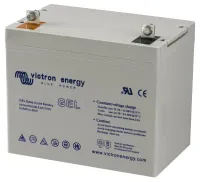Victron Pb battery GEL 12V 60Ah
VICTRON | BAT412550104 | 8719076037149

Price of goods is 164.45 €.
Price without tax is 135.91 €.
Weight of goods is 19.06 Kg.
Actual in cart 0 pcs.
Victron Pb battery GEL 12V/60Ah
Backup 12 V (60 Ah) lead battery in VRLA (GEL) design suitable for applications where there is frequent and deep discharge/cycling.
Victron Energy solar battery in which the electrolyte is bound in a special gel. Gel batteries are characterized by a longer service life and a greater number of cycles.
Victron 60 Ah Deep Cycle VRLA GEL lead-acid battery with advanced technology of bonding the electrolyte to silicon gel brings a number of indisputable advantages over classic batteries with liquid electrolyte. The most significant ones are absolute maintenance-free throughout the lifetime, low rate of self-discharge, temperature stability, high resistance to deep discharge and subsequent quick "recovery", reduced influence of vibrations and mechanical damage to gel-fixed plates, no layering of the electrolyte with all negatives and low corrosion of electrodes and sulphation.
Victron Energy gel batteries are intended for smaller photovoltaic solar applications of the Off-Grid type (island applications), for example for powering cottages and other objects outside the reach of the power grid with seasonal operation. For use in hybrid systems with daily cyclic operation, OPzS, OPzV or lithium batteries with significantly greater cyclic resistance are significantly more suitable.
VRLA technology
The universal abbreviation VRLA stands for Valve Regulated Lead Acid (Valve Regulated Lead Acid). The battery case is completely closed and without inspection holes to check the electrolyte. Gas can eventually escape only through the safety overpressure valves if the battery is significantly overcharged or one or more cells are damaged. Electrolyte cannot be added to the battery.
Electrolyte bound in gel
The electrolyte is bound by adhesive forces in the capillaries of the silicon gel, which functions as a carrier. Thanks to the binding of the electrolyte in the gel and the non-corroding plastic case, the risk of acid leakage is zero. Thanks to the closed design, the leakage of vapors is minimized, which predisposes the battery to use in living spaces (for example, caravans).
Low self-discharge
Every battery undergoes a natural process of self-discharge and a decrease in the amount of stored energy. The rate of self-discharge is an important figure, especially in systems with very long recharging intervals or when the battery is stored and not in use. Thanks to the use of highly pure materials and the enrichment of lead plates with calcium, the self-discharge process is minimized. The self-discharge rate is less than 2% of the total capacity per month at 20°C. Every 10°C increase in temperature doubles the self-discharge rate. If a fully charged battery is stored at low temperatures (not freezing), it may not be recharged in any way for approximately one year without damage.
Deep discharge resistance
Any discharge damages any lead-acid battery. The amount of damage is determined by the depth and duration of the discharge. Victron energy gel batteries are no exception in this regard, but they are extremely resistant to the effect of deep discharge and the effect of its long duration.
Discharge characteristics
Battery capacity is not a stable value. It mainly depends on the magnitude of the discharge current. The stated capacity of 60 Ah refers to a twenty-hour discharge time with a final discharge voltage of 10.8 V. In other words, the stated capacity applies if we discharge the battery for twenty hours with a current of 0.05 x the stated capacity, i.e. 0.05 x 60 Ah = 3 A. The smaller this current will be, the more energy we will get from the battery and vice versa. However, thanks to the design of gel batteries, the effect of large discharge currents on the total battery capacity is relatively small. Within the framework of closed battery types, it also tolerates large shock current drawdowns due to low internal resistance (e.g. starting) in an excellent way.
Lifetime
Cycle life: 500 cycles at 80% discharge, 750 cycles at 50% discharge and 1800 cycles at 30% discharge. Lifetime of 12 years in continuous (float) charging operation at 20 °C. The battery is suitable both for cyclic operation (discharge-charge) and for continuous recharging with a small degree of discharge.
Charging
We recommend standard adaptive three- or four-phase charging (bulk = BULK, absorption = ABSORPTION, maintenance = FLOAT and possibly storage phase = STORAGE). The battery is not designed for charging with constant voltage and current, there is a risk of overcharging and gas formation. The recommended charging voltage values are listed below in the technical parameters. The charging current should not exceed 20% of the battery capacity. Temperature compensation of the charging voltage is recommended at temperatures below 10 or above 30 °C. At higher temperatures the charging voltage should be reduced, at lower temperatures it should be increased. We recommend a temperature compensation value of 4 mV per cell and a one-degree temperature deviation from the standard 20 °C. We recommend compensation especially for large charging currents. With all the mentioned advantages and properties, gel batteries are extremely favorable for smaller photovoltaic solar applications of the Off-Grid type (island application), for example for powering cottages and other objects outside the reach of the electrical grid. Gel batteries are different from classic batteries with liquid electrolyte
| Name | Value | |
|---|---|---|
| Weight, brutto [kg] | 20 | |
| Connector | M6 | |
| Battery capacity [Ah] | 60 | |
| Battery/cell voltage [V] | 12 | |
| Battery technology | Leaded | |
| Max. output current [A] | 12 | |